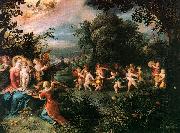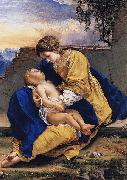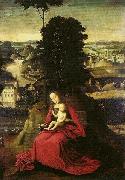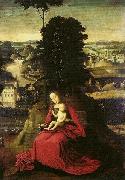Wholesale Oil Painting No Minimum |
|||||||||||
|
|
|||||||||||

|
|||||||||||
|
|
|
||||||||
Francken, Frans IIb. 1581, Antwerpen, d. 1642, Antwerpen Painter, son of Frans Francken I. Of all the members of the Francken family, Frans II is the most important and still the most widely known. There are paintings by him in all large public collections in Europe. Besides altarpieces and painted furniture panels, he produced mainly small cabinet pictures with historical, mythological or allegorical themes. Frans II's rank as an artist is not so much derived from his extensive output as from his innovative subject-matter: his depictions of luxuriously decorated Kunstkammern and art galleries |
||||||||
|
|
||||||||
Madonna and Child in a Landscape
Madonna and Child in a Landscape Painting ID:: 19035 |
undated, oil on copper, Mus??e des Beaux-Arts, Lyons. undated, oil on copper, Mus??e des Beaux-Arts, Lyons. |
|||||||
|
|
||||||||
Orazio Gentileschi1563-1639 Italian Orazio Gentileschi Galleries Tuscan painter, b. Pisa. His real surname was Lomi, but he adopted his uncle name. He studied in Rome, where he was associated with Agostino Tassi in the decoration of palace interiors. Influenced by Caravaggio, Gentileschi developed a more softly luminous light and a cooler, more lyrical style. He also painted frescoes in Santa Maria Maggiore and in the Lateran. After spending several years in Genoa and in France, he settled in England (1626) at the invitation of Charles I. Gentileschi principal works include The Annunciation (San Siro, Genoa); Flight into Egypt (Louvre); Sibyl (Hampton Court, England); and Moses Saved from the Waters (Prado). He also painted numerous portraits. Artemesia Gentileschi was his daughter. |
||||||||
|
|
||||||||
|
|
Madonna and Child in a Landscape
Madonna and Child in a Landscape Painting ID:: 79611 |
Oil on copper, 11 x 8 in
Date 1621-22
cyf Oil on copper, 11 x 8 in Date 1621-22 cyf |
||||||
|
|
||||||||
Adriaen Isenbrant(between 1480 and 1490 - Bruges, July 1551), was a Flemish Northern Renaissance painter, who from documentary evidence was clearly a significant artist of his period, but to whom no specific works can be clearly documented. As hypothesised by art historians, he ran a large workshop specializing in religious subjects and devotional paintings, painting conservatively in the tradition of Early Netherlandish painting. He is believed by some to be the anonymous Master of the Seven Sorrows of the Virgin. Other art historians doubt that any works can be reliably attributed to him, and the number of paintings attributed to him by major museums has been in decline for many decades. There are only a few documentary records of his life, and some mentions in literature from his lifetime or soon after, but he cannot be documented as the creator of any surviving work; everything else consists of hypothesis. It is possible that he was born in Haarlem or even in Antwerp about 1490. It is not known where or with which painter he served his apprenticeship. He is named for the first time in 1510, when he came to Bruges and bought his burghership. In November of the same year he already became master in the painterse Guild of St. Luke and the goldsmithse guild of St. Elooi. He was later elected nine time a deacon (in Old Dutch : vinder) and twice the governor (in Old Dutch : gouverneur = treasurer) of the guild. Soon he had an important workshop, probably in the Korte Vlaminckstraat in Bruges. This was close to the workshop of Gerard David, at the Vlamijncbrugghe and the former workshop of Hans Memling. Bruges, at that time, was one of the richest towns in Europe. Rich traders and merchants ordered diptychs and portraits for personal use. Isenbrandt painted mainly for private clients. However, there were some paintings that were created without any particular commission. He had enough work to even put out work to other painters in Bruges, as a legal suit from 1534 by Isenbrandt against Jan van Eyck (not the famous one) for non-delivery of paintings he had ordered, demonstrates. He was also appointed the agent in Bruges of the painter Adriaan Provoost (son of Jan Provoost), who had moved to Antwerp in 1530. Contemporary sources therefore mention Isenbrandt as a famous and well-to-do painter. He married twice, the first time with Maria Grandeel, daughter of the painter Peter Grandeel. They had one child. After her death in 1537, he married again in 1547 with Clementine de Haerne. This second marriage resulted in two daughters and a son. He also had an extramarital daughter with the innkeeper Katelijne van Brandenburch (who was at the same the mistress of his friend Ambrosius Benson). When he died in 1551, he was buried alongside his first wife at the cemetery of the St. Jacob church in Bruges; his children inherited no less than four houses with surrounding property. |
||||||||
|
|
||||||||
|
|
Madonna and Child in a landscape
Madonna and Child in a landscape Painting ID:: 81181 |
Date 16th century
Medium Oil on wood
Dimensions 106 x 75 cm (41.7 x 29.5 in)
cjr Date 16th century Medium Oil on wood Dimensions 106 x 75 cm (41.7 x 29.5 in) cjr |
||||||
|
|
||||||||
Adriaen Isenbrant(between 1480 and 1490 - Bruges, July 1551), was a Flemish Northern Renaissance painter, who from documentary evidence was clearly a significant artist of his period, but to whom no specific works can be clearly documented. As hypothesised by art historians, he ran a large workshop specializing in religious subjects and devotional paintings, painting conservatively in the tradition of Early Netherlandish painting. He is believed by some to be the anonymous Master of the Seven Sorrows of the Virgin. Other art historians doubt that any works can be reliably attributed to him, and the number of paintings attributed to him by major museums has been in decline for many decades. There are only a few documentary records of his life, and some mentions in literature from his lifetime or soon after, but he cannot be documented as the creator of any surviving work; everything else consists of hypothesis. It is possible that he was born in Haarlem or even in Antwerp about 1490. It is not known where or with which painter he served his apprenticeship. He is named for the first time in 1510, when he came to Bruges and bought his burghership. In November of the same year he already became master in the painterse Guild of St. Luke and the goldsmithse guild of St. Elooi. He was later elected nine time a deacon (in Old Dutch : vinder) and twice the governor (in Old Dutch : gouverneur = treasurer) of the guild. Soon he had an important workshop, probably in the Korte Vlaminckstraat in Bruges. This was close to the workshop of Gerard David, at the Vlamijncbrugghe and the former workshop of Hans Memling. Bruges, at that time, was one of the richest towns in Europe. Rich traders and merchants ordered diptychs and portraits for personal use. Isenbrandt painted mainly for private clients. However, there were some paintings that were created without any particular commission. He had enough work to even put out work to other painters in Bruges, as a legal suit from 1534 by Isenbrandt against Jan van Eyck (not the famous one) for non-delivery of paintings he had ordered, demonstrates. He was also appointed the agent in Bruges of the painter Adriaan Provoost (son of Jan Provoost), who had moved to Antwerp in 1530. Contemporary sources therefore mention Isenbrandt as a famous and well-to-do painter. He married twice, the first time with Maria Grandeel, daughter of the painter Peter Grandeel. They had one child. After her death in 1537, he married again in 1547 with Clementine de Haerne. This second marriage resulted in two daughters and a son. He also had an extramarital daughter with the innkeeper Katelijne van Brandenburch (who was at the same the mistress of his friend Ambrosius Benson). When he died in 1551, he was buried alongside his first wife at the cemetery of the St. Jacob church in Bruges; his children inherited no less than four houses with surrounding property. |
||||||||
|
|
||||||||
|
|
Madonna and Child in a landscape
Madonna and Child in a landscape Painting ID:: 85226 |
16th century
Medium Oil on wood
Dimensions 106 x 75 cm (41.7 x 29.5 in)
cyf 16th century Medium Oil on wood Dimensions 106 x 75 cm (41.7 x 29.5 in) cyf |
||||||
|
|
||||||||
|
Adriaen Isenbrant (between 1480 and 1490 - Bruges, July 1551), was a Flemish Northern Renaissance painter, who from documentary evidence was clearly a significant artist of his period, but to whom no specific works can be clearly documented. As hypothesised by art historians, he ran a large workshop specializing in religious subjects and devotional paintings, painting conservatively in the tradition of Early Netherlandish painting. He is believed by some to be the anonymous Master of the Seven Sorrows of the Virgin. Other art historians doubt that any works can be reliably attributed to him, and the number of paintings attributed to him by major museums has been in decline for many decades. There are only a few documentary records of his life, and some mentions in literature from his lifetime or soon after, but he cannot be documented as the creator of any surviving work; everything else consists of hypothesis. It is possible that he was born in Haarlem or even in Antwerp about 1490. It is not known where or with which painter he served his apprenticeship. He is named for the first time in 1510, when he came to Bruges and bought his burghership. In November of the same year he already became master in the painterse Guild of St. Luke and the goldsmithse guild of St. Elooi. He was later elected nine time a deacon (in Old Dutch : vinder) and twice the governor (in Old Dutch : gouverneur = treasurer) of the guild. Soon he had an important workshop, probably in the Korte Vlaminckstraat in Bruges. This was close to the workshop of Gerard David, at the Vlamijncbrugghe and the former workshop of Hans Memling. Bruges, at that time, was one of the richest towns in Europe. Rich traders and merchants ordered diptychs and portraits for personal use. Isenbrandt painted mainly for private clients. However, there were some paintings that were created without any particular commission. He had enough work to even put out work to other painters in Bruges, as a legal suit from 1534 by Isenbrandt against Jan van Eyck (not the famous one) for non-delivery of paintings he had ordered, demonstrates. He was also appointed the agent in Bruges of the painter Adriaan Provoost (son of Jan Provoost), who had moved to Antwerp in 1530. Contemporary sources therefore mention Isenbrandt as a famous and well-to-do painter. He married twice, the first time with Maria Grandeel, daughter of the painter Peter Grandeel. They had one child. After her death in 1537, he married again in 1547 with Clementine de Haerne. This second marriage resulted in two daughters and a son. He also had an extramarital daughter with the innkeeper Katelijne van Brandenburch (who was at the same the mistress of his friend Ambrosius Benson). When he died in 1551, he was buried alongside his first wife at the cemetery of the St. Jacob church in Bruges; his children inherited no less than four houses with surrounding property. Madonna and Child in a landscape 16th century Medium Oil on wood Dimensions 106 x 75 cm (41.7 x 29.5 in) cyf |
||||||||
|
|
||||||||
|
Prev Next
|
||||||||
|
|
||||||||
|
Related Paintings to Adriaen Isenbrant :. |
||||||||
|
|
||||||||
|
CONTACT US |




